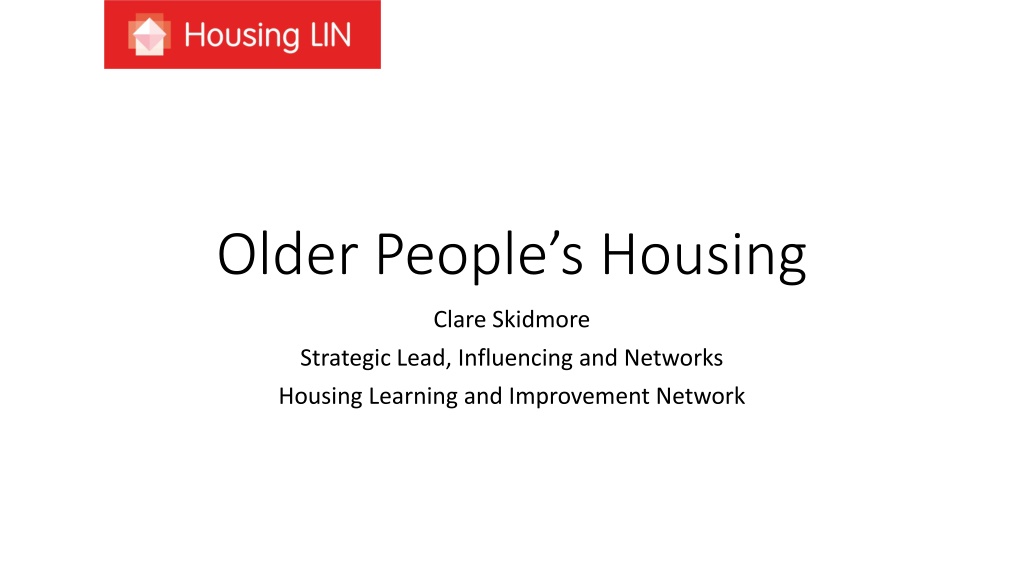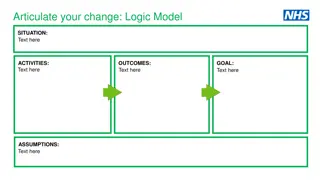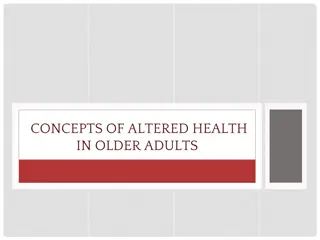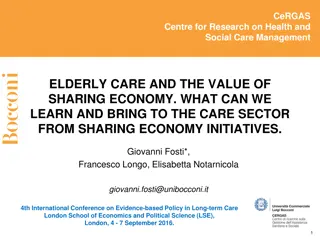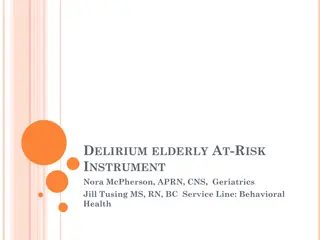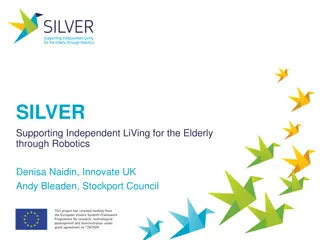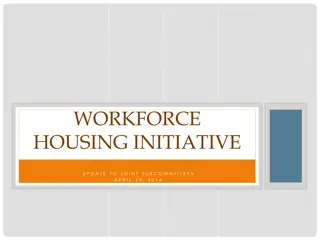National Initiatives for Improving Elderly Housing and Care
National initiatives such as the Health and Social Care Act, Better Care Fund, and MHCLG/DWP Supported Housing are emphasizing the importance of housing solutions for the elderly. Efforts are being made to integrate health and care services, promote healthy communities, and provide specialized housing options. The focus is on enhancing the well-being of older individuals through improved housing and care arrangements.
Download Presentation

Please find below an Image/Link to download the presentation.
The content on the website is provided AS IS for your information and personal use only. It may not be sold, licensed, or shared on other websites without obtaining consent from the author. Download presentation by click this link. If you encounter any issues during the download, it is possible that the publisher has removed the file from their server.
E N D
Presentation Transcript
Older Peoples Housing Clare Skidmore Strategic Lead, Influencing and Networks Housing Learning and Improvement Network
With thanks to Jim McManus, DPH, Herts County Council
Consider The person who has not left their home for 7 years, apart from for hospital visits, because they live on the second floor with no lift and cannot leave the building The older person with mobility difficulties, living in a large, unsuitable home far from family and old friends, with no access to outside space from which to encounter friendly neighbours, and no suitable indoor space within which they feel comfortable hosting visitors Anyone who is living in any kind of housing situation where they are uncomfortable, feel insecure, unsafe, isolated, and or have no control over their own life How easy would it be for anybody to enjoy healthy, active social interaction with others, when faced with these challenges? *For the source of these examples and for much more qualitative and quantitative evidence, see Housing and Disabled People: Britain s Hidden Crisis , EHRC, May 2018
National Context Health and Social Care Act - created Health & Well Being Boards Care Act - an emphasis on housing/home based solutions Better Care Fund promoting integration including Housing (also see DFG Review) NHS Long Term Plan Healthy New Towns, care at home MHCLG / DWP Supported Housing funding new regulatory arrangements Improving Health and Care through the Home National MoU All Party Parliamentary Group on Housing and Care HAPPI 4 Report - focus on rural housing and older people s housing National Planning Policy Framework planning for older and disabled people and for healthy communities (still waiting ) Social Housing Green Paper July 2018 Adult Social Care Green Paper - still waiting!
https://encrypted-tbn3.gstatic.com/images?q=tbn:ANd9GcTnrWqj1R_v7R9Y5tox-XYAyUkTAVRPBmZNTqUcJKXeBf8YlUFYih6gxaAhttps://encrypted-tbn3.gstatic.com/images?q=tbn:ANd9GcTnrWqj1R_v7R9Y5tox-XYAyUkTAVRPBmZNTqUcJKXeBf8YlUFYih6gxaA Aligning Funding Opportunities Better Care Fund (BCF) - brings together money from a number of health and local government budgets to enable better (more integrated) ways of delivering health and care services, including Disabled Facilities Grant funding (for housing adaptations). DH Care and Support Specialised Housing Fund (CASSH) - to support development of specialised housing for older people. On 8 June 2018, Homes England announced extension of Phase 2 of this Capital Fund ( 76m p.a.) to 2021. Other Homes England funding programmes including new large scale programme of strategic partnerships for the development of affordable homes Opportunities arising from the removal of the Housing Revenue Account cap (HRA) Personal Health Budgets and Integrated Personal Commissioning holistic focus on individual person supports opportunities to bring together range of funding sources to ensure good outcomes for that person, including housing, care and health, alongside other key fundamentals of life
What do we know about older people and their housing? Tenure 9% of people over the age of 50 are privately renting in England (NHF 2018 private renters report) 17% of people over 50 rent from a housing association or their local council 74% of people over 50 own their home, with or without a mortgage Finances Those who own their home outright are significantly more likely to have income from a private pension (63%) and from investments (21%) than those who rent in any tenure. They also have greater amounts saved than those living in other tenures; half (50%) have savings of 10,000 or more and a fifth (19%) have savings of 100,000 or more Just under a sixth (15%) of those aged 50 and over said they had no savings or investments to support retirement, rising to nearly half of local authority tenants (49%) and two fifths (42%) of housing association tenants. Just under a third (31%) of those who rent from a private landlord have no savings or investments for retirement. *https://www.housinglin.org.uk/Topics/browse/HousingExtraCare/ExtraCareStrategy/SHOP/SHOP_Practice/DeliveringKeyOutcomes/Downsizing/; for detail, see RIGHTSIZING: Reframing the housing offer for older people: PHASE @ Manchester School of Architecture, 2018
Suitability of home Just under half (46%) of people aged 50+ across all tenures said they did not have all the adaptations they needed to be as independent as they would like Other research (English Housing Survey) showed that private renters of any age with a long-term limiting disability were the most likely to feel that their accommodation was unsuitable for their needs (32%), compared to 22% of housing association tenants and 23% of local authority tenants *https://www.housing.org.uk/resource-library/browse/experiences-of-those-aged-50-in-the-private-rented-sector/ *https://assets.publishing.service.gov.uk/government/uploads/system/uploads/attachment_data/file/539541/Adaptations_and_Accessibility_Report.p df
Wider Evidence Right sizing Most older people do not move into specialist housing, although for those who do choose to, it can have significant benefits. Most older movers do not downsize many move to homes of a similar or larger size. For those people who do choose to move, quality of life is key consideration. Decisions based on complex range of issues including: emotional attachment, proximity to social networks, financial benefits, costs of / available support for moving, and the availability of suitable (including accessible) housing options. Over 14% of private renters in the 50-69 age group move every year. This makes them over three times more likely to move than those who own or socially rent their homes. (Evandrou et al., 2010, p. 87). Only 39% of older homeowners who moved to a new-build home between 2010 and 2016 downsized to a home with fewer bedrooms, a third moved to a home with the same number and 28% upsized to a home with additional bedrooms (NHBCF, 2017). *https://www.housinglin.org.uk/Topics/browse/HousingExtraCare/ExtraCareStrategy/SHOP/SHOP_Practice/DeliveringKeyOutcomes/Downsizing/
The Right Sizing Gap Research* suggests that most older people (60%) are in a right sizing gap, with little opportunity to move from current home, regardless of suitability; only wealthiest 10% / least wealthy 30% have adequate options This 60% includes: Older parents who live with their adult children. There are 3.35m adults (aged 20-35) who currently live with their (older) parents (Bone, 2014, p. 3). Those seeking to make proactive, midlife moves in social rental accommodation, due to high demand from people with higher needs for support. Those seeking low levels of formal or informal social support, who often end up in specialist housing with higher levels of care than desired. (Pennington 2013). Older people with low levels of savings or income, who struggle to afford removal services, stamp duty, survey, legal fees or rental deposits (Pannell et al., 2012, p. 44). Increasing numbers of older private renters, for whom the loosely regulated private rental market provides few protections or support in changing circumstances. * Manchester School of Architecture, 2018 - https://www.housinglin.org.uk/News/Rightsizing-Report-Reframing-the-housing-offer-for-older-people/
Housing for Older People CLG Select Committee Report, 2018 25% - 33% of older people interested in moving at any one time although as stated already, they are often right sizing rather than down sizing Top reasons for wanting to move: Too many stairs, too big a garden, concerns about repairs and maintenance, care and health needs which cannot be managed in existing home, wanting to be nearer family, desire to reduce maintenance bills, and to release capital to fund retirement. Top barriers to people actually making the move: Cost of moving; general hassle of process, and inevitable physical exhaustion arising; stressful prospect of sorting through a lifetime s belongings, and emotional toll of leaving family home behind; lack of access to information / advice about housing options; and lack of suitable, desirable housing options available
What do older people want? terms of age, race / ethnicity, religion, sexual orientation, interests, lifestyle preferences etc. Most older people prefer to stay in their home with some adaptations if they need them in the future No typical older person people over 50 are as diverse as any other group, in However for those who do want to move, there are some common themes. Survey data suggests that people are overwhelmingly positive about good design, aligning well with HAPPI principles. Top priorities: *Building for the Baby Boomers: Making a housing market for an ageing population Policy Exchange, 2018 Accessibility features (significant, though surprisingly few older people surveyed said they needed this) Attractiveness (i.e. aesthetic design of homes and surroundings), light, space etc. Proximity to greenery and open space Energy efficiency and quality of build built to last Proximity to shops and other amenities A sense of fittingness with other homes Majority prefer to stay within 5 miles of existing home, to preserve social networks and community links Some do want to move further afield though, to be nearer family or for health reasons Key features which people would pay extra for: transport links, parks and large rooms
Dwell: Designing with Downsizers University of Sheffield, 2016 Co-design process generated a number of key themes: Demand for single storey or two storey homes, with continuing appetite for bungalows Willingness to consider apartment living, as long as offer feels secure, spacious and in a good location, and potentially alongside other facilities e.g. allotments, shared space for social activities Demand for fewer (bed)rooms but more flexible space and adaptability to accommodate separate living, visiting friends and family, and grandchildren Provision of manageable outdoor space for gardening and relaxation, e.g. courtyard gardens, roof terraces and generous balconies Dedicated resident and visitor car parking facilities for all but the most centrally located sites A home that allows people to pursue the pleasures of life today, while feeling secure that their home can adapt to their future needs * https://www.housinglin.org.uk/_assets/DWELL_DesigningWithDownsizers.pdf
Ebbsfleet Focus Groups / Interviews Aged 55-79, Dartford / Gravesham residents, men / women, mix of tenures, range of levels of physical ability. Affordable housing for local people who want to stay in the area in the long term Top priority placed on living in an attractive and suitable location Inclusive design in the home and in the wider neighbourhood High quality, accessible public transport and local amenities / shared spaces Desirability of places that encourage neighbourliness , social interaction, mutual support for one another Mixed feedback on the question of age-designated vs intergenerational living about 50/50 either way
Demand for Specialist / Retirement Housing Only 0.6 per cent of over 65s live in housing with care, 10 times less than in more mature retirement housing markets such as the USA and Australia (5%). EAC estimates a substantial shortfall in housing and care provision by 2035 of nearly 400,000 units of purpose built housing for older people (23,000 pa). (See Housing our Ageing Population , LGA, 2017). Savills: 18,000 homes extra homes for older people a year needed simply to maintain existing levels of provision as the population ages. Demos: annual demand for new homes purpose-built for older people - over 30,000. Increasing provision of retirement housing to match international benchmarks would require a total of 78,000 new homes aimed at older people per annum Building for the Baby Boomers, Policy Exchange, 2018: https://policyexchange.org.uk/wp-content/uploads/2018/11/Building-for-the-Baby-Boomers-Jack-Airey-Policy- Exchange-December-2018.pdf https://www.housinglin.org.uk/Topics/type/Housing-our-Ageing-Population-Learning-from-councils-meeting-the-housing-needs-of-our-ageing-population/
Benefits of specialist housing: the evidence* Residents of retirement communities are more socially connected / less prone to loneliness Living in a care village increases life expectancy by up to 5 years People living in extra care housing needed less formal care, as measured by the size of their care packages , compared to a control group in the community Extra care housing residents unplanned hospital admissions reduce from 8-14 days to 1-2 days, compared to the community Over a 12 month period, total NHS costs (including GP visits, practice and district nurse visits and hospital appointments and admissions) reduced by 38% for extra care residents * Demonstrating the Health and Social Cost-Benefits of Lifestyle Housing for Older People, Housing LIN (report for Keepmoat Regeneration), October 2017
Beyond specialist housing benefits of good design 2009 HAPPI 1 Report identified ten overarching features that underpin age-ready housing and which have already significantly influenced the development of new age ready housing Homes designed for people in later life achieve cost savings and have significant benefits in health and wellbeing, including tackling isolation and loneliness, while also releasing capital to improve the incomes and quality of life of older people HAPPI 3 (2016) provides more information, evidence and examples of new models of provision which achieve these outcomes and benefits * https://www.housinglin.org.uk/Topics/browse/Design-building/HAPPI/
Emerging trends? Not everyone wants to live in a retirement village, but it is an important option and works well for many. The demand for more dedicated retirement and extra care housing to meet a clear and indeed rising level of need will continue Doing it for ourselves/co-design - a growing interest and necessity for next generation of older people; resident-led, self-care, mutual ownership, co-housing, virtual villages, age-friendly communities Care ready housing - more closely integrated housing; care and support commissioned locally to reduce dependency, and address long term conditions such as dementia Bruyn Court, Thurrock: Designed to HAPPI principles and with a mix of five 1-bed flats, seventeen 2-bed 3-person flats, and three 2-bed 4-person flats, plus a common room at ground floor, but with no other communal functions or services such as concierge or on-site staff, residents are expected to be autonomous Excellent location, near community wellbeing hub / shops https://www.housinglin.org.uk/_assets/Resources/Housing/Practice_examples/Housing_LIN_case_stu dies/HLIN_CaseStudy_145_BruynsCourt.pdf
Rural Housing for an Ageing Population: Preserving Independence - HAPPI 4 APPG (Housing and Care for Older People) Inquiry - older people's housing is neglected in rural areas, and, Small scale provision in large numbers of villages often the preferred solution for those who otherwise simply refuse to take the step of moving from unsuitable properties New, purpose built accommodation for right sizing could preserve independence / reduce need for care and support However, the inquiry concludes that in rural areas: Until measures in place for private sector players to meet local need, accommodation for older people will usually require involvement of housing associations, Councils, or other not for profit bodies e.g. Community Land Trusts/ almshouses Special measures are needed to secure homes suitable for older people increasingly representing the majority of residents living in rural communities Recommendations include: Every Strategic / Local Plan should ensure specific sites are allocated for the housing of older people across all tenures, thereby enabling provision which cannot be achieved through open market competition for sites All new homes should be built to the Lifetime Homes standards of accessibility that serve the needs of people of all ages Local Planning Authorities should pay regard to needs of older people in rural areas and key workers to support them
Impact of housing on health /care costs and outcomes* Lightbulb Project, Leicestershire: Community based housing support services - aids / adaptations, information / advice, warmth and energy, technology, equipment and housing options (planning ahead) Integrated, proactive approach including GPs and other health professionals Also includes housing enabler role based within hospital settings Evidenced savings to the wider system include Reduction in service utilisation (health and social care) Reduction in A&E attendance, and reduced hospital admissions Reduction in Delayed Transfers of Care Falls prevention Lower DFG delivery costs through more efficient processes and staffing * The Lightbulb Project: Switched on to integration in Leciestershire, Housing LIN Case Study, July 2017
Disabled Facilities Grant Review Identified multiple challenges with current system including: more complex cases coming through; little analysis of local needs and minimal advertising; delivery process often slow and cumbersome; very complex process; tenure inequity; all too often decisions made at crisis point, rather than in a preventative way (more costly). Recommendations: Housing and Health Partnership Board in each area as requirement of DFG funding (housing, health and care) The DFG and Integrated Community Equipment (ICES) budgets to be in the Better Care Fund (or its successor) to join up DFG services with equipment provision and minor adaptations A single adaptations policy based on needs of the locality, annually signed off by Health & Wellbeing Board Integrated teams in all areas to simplify and speed up customer journeys Better analysis of local need to inform preventative strategies / determine levels of revenue / capital funding Single point of access with good conversations at the start and people routed down appropriate pathways Regulatory Reform Order (RRO) policies to be adopted in all areas to provide more flexible use of the grant. LAs / HIAs to provide advice, information, and handyperson services for people outside the DFG
Looking to the Digital Future The Future of House and Home report, published by Shelter in 2016: People who will be 80+ in 2030 are in their 60s, or younger, today; they will be more familiar with digital than many older people now Greater rise of home monitoring technology, wearables , and telehealth / wellness apps in everyday life; smart homes will be increasingly the norm Digital technology: even more ubiquitous by 2030 than now. Personal devices will routinely engage with sensors / embedded digital technology Tech will be more lightweight, based on phones and tablets rather than laptops and computers What do these trends mean for how housing, health and care will be working together in the future? Are we developing holistic strategies for moving successfully into and making the most of the digital age? Are we developing good relationships with tech and digital developers / suppliers, and are we (local authorities, housing providers, care providers, other organisations who work with older people and their families) developing our own expertise and knowledge in this area? https://england.shelter.org.uk/professional_resources/policy_and_research/policy_library/policy_library_folder/report_the_future_of_housing_and_hom e_scenarios_for_2030
Central Bedfordshire Councils approach to housing and social care thanks to Tim Hoyle, Assistant Director Strategic Commissioning, Central Bedfordshire Council Understands the critical contribution that housing makes to health and wellbeing Considers the whole market not just those needing public support. Addressing entire continuum from general needs housing to care and nursing homes Keen to use Council land and other assets where appropriate and to maximum effect Keen to engage with the market and to develop partnerships. Use most appropriate delivery model for circumstances.
Delivering Change with Housing-based Interventions Short-Term Medium-Term Long Term Concept Enhance & Reuse Develop Plan & Develop Time to deliver 1-2 years 3-5 years 6 years + Building-based initiatives Repurpose Repair Adapt Refurbish New build schemes Simple regeneration schemes Complex regeneration schemes New villages, neighbourhoods and towns People-based initiatives Prevention schemes Homelessness interventions Integration of housing, social care and health Examples IBCF-funded Housing Team New housing-with- care schemes Healthy Neighbourhoods
Central Bedfordshire - Initiatives and Actions Housing Support for Hospital Discharge Dedicated housing service for people coming out of hospital; avoids admission to residential care (short term; ongoing - part of prevention strategy) Tenancy support and housing assistance Supports tenants to avoid debt, and to access appropriate health / care; prevents tenancy breakdown, avoids homelessness (short term; ongoing - part of prevention strategy) Development of new Housing-with-Care / Support schemes for older people New affordable specialist housing; reduced res care admissions, reduced health / care costs, better outcomes, frees up larger homes (medium term: 3-5 years) Development of Investment Prospectus for Accommodation for Older People Sets out Central Bedfordshire s aspirations in terms of accommodation for older people, to attract investment into the area, focusing on types of accommodation that are most needed (medium term): goo.gl/GJLnpC Research into housing needs of older people Provides evidence-base to determine the shape of new housing; influences Local Plan policies to enable delivery of homes suitable for older people (long term)
Influencing Planning Policy As a result of this research we have proposed clear policies that: Define housing suitable for older people Require a percentage (23%) of any new development to be suitable for older people This increases to 100% for developments within existing settlements (with some caveats) Require larger developments to have suitable housing-with-care and/or housing-with-support schemes
Going Further - Promoting Innovation Acquire sites and or allocate existing sites in the Council s ownership Deliver exemplar housing designs and schemes: Low cost / high quality / high density Unit-based designs scalable solutions Investigate benefits of using smarter construction methods Explore options for subsequent delivery at scale Continuing research and engagement with older people For more detail on Central Bedfordshire s approach please go to: https://www.housinglin.org.uk/_assets/Events/2018-11/Tim-Hoyle-Presentation-to-ADASS-Eastern-Region-Housing-LIN- 22nd-November-2018.pptx
